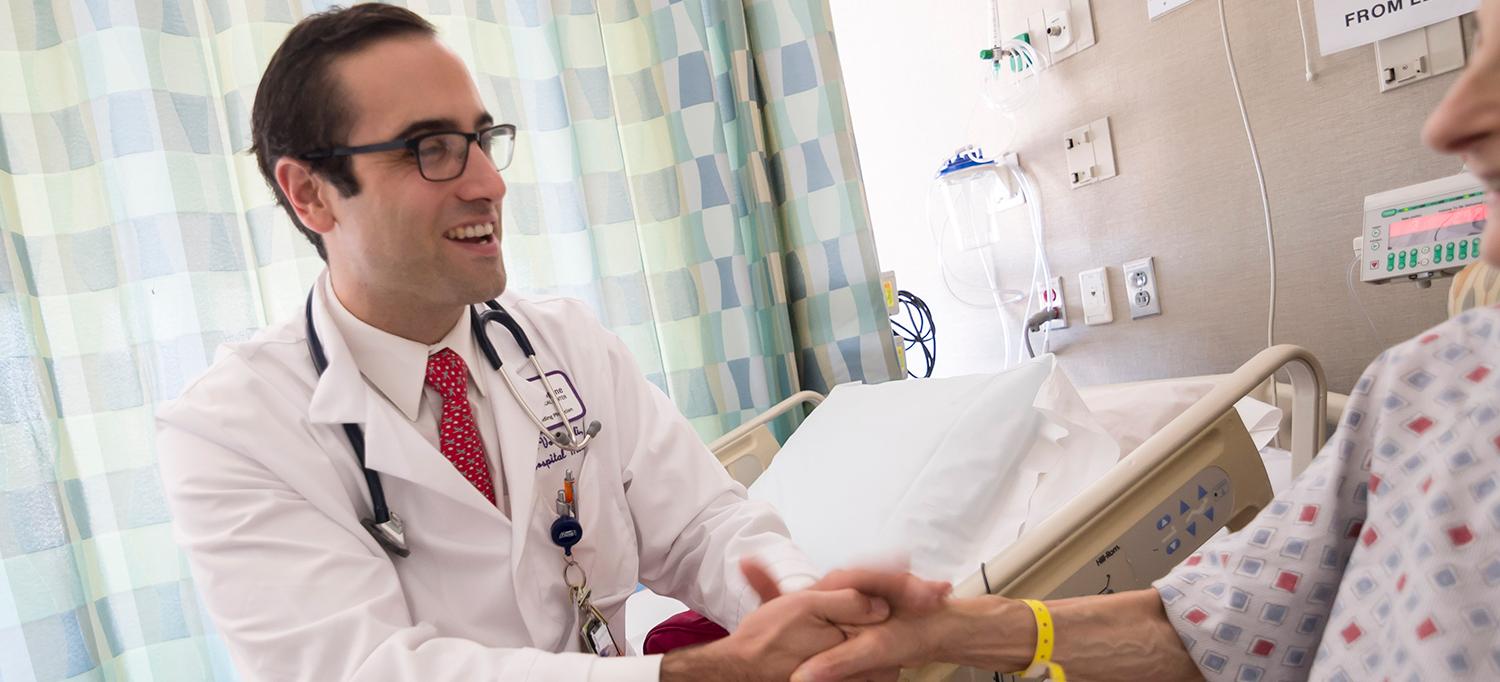NYU Langone Hospital—Brooklyn Expands Its Team of Doctors Who Care Exclusively for Inpatients

Frank M. Volpicelli, MD, caring for a hospitalized patient.
Photo: Karsten Moran
About half of NYU Langone Hospital—Brooklyn’s inpatients are tended to by hospitalists, internists dedicated to caring for hospitalized patients. Last year, NYU Langone expanded and formalized NYU Langone Hospital—Brooklyn’s hospitalist program, ensuring that every medical floor and unit is covered 24/7 by one of the 21 attending physicians who make up the hospitalist team. Each hospitalist is in charge of coordinating the treatment of more than a dozen acutely ill patients at a time.
Spurred by mounting pressure to reduce costs and improve quality, hospitals started to embrace this new model of care over 20 years ago. Today, hospital medicine is the fastest-growing medical specialty and the largest subspecialty in internal medicine. “As hospitalized patients become older and sicker, and as growing demands on community-based primary care physicians make it harder for them to attend to their hospitalized patients,” explains Steven B. Abramson, MD, chair of NYU Langone’s Department of Medicine, “the role of hospitalists is becoming increasingly important.” Here are five reasons why NYU Langone is committing more resources to NYU Langone Hospital—Brooklyn’s hospitalist medicine:
1. Hospitalists Are Internists, but a Special Kind
Hospitalists have a broad, deep knowledge of medicine, coupled with a savviness that enables them to navigate a large institution and orchestrate care amid ever-changing information. Typically, a hospitalist consults specialists, distilling their perspectives and sometimes conflicting opinions into a diagnosis—a daunting challenge. “Hospitalist medicine is a true subspecialty,” says Frank M. Volpicelli, MD, chief of medicine at NYU Langone Hospital—Brooklyn. “We’re internists, and we specialize in acute inpatient care. We’re major deciders of how to deliver quality, cost-efficient care in a complex environment, and because one of us is always on duty, we can monitor subtle changes in the patient’s condition and be at their bedside within minutes.”
2. Hospitalists Do Their Best to Help Patients Leave the Hospital
The longer you stay in the hospital, goes the saying, the longer you stay in the hospital. Hospitalists serve as champions of quality and safety. Ever vigilant, they ensure that proper precautions and preventive measures are taken to protect the patient. “A patient should not be hospitalized any longer than necessary, and it’s certainly rewarding to turn around someone’s health dramatically in a short time,” says Charles M. Okamura, MD, director of NYU Langone Hospital—Brooklyn’s hospitalist program. “But safety comes first, so we only discharge patients when they have improved to the point where they no longer need closely monitored, acute-level care.”
3. A Hospitalist Is Your Doctor’s Partner, Not Proxy
When a newly admitted patient has an established primary care physician, that doctor decides whether they want their patient placed under the day-to-day care of a hospitalist. If so, the hospitalist partners with the private physician, providing status updates, especially during admission and discharge—“the periods of highest risk,” explains Dr. Volpicelli. When a patient is admitted, they are at their sickest, so the hospitalist must act quickly to compile a complete medical history, perform an evaluation, order appropriate tests, confer with specialists, make a correct diagnosis, devise a treatment plan, and ensure that new medications don’t interact or conflict with existing ones. When a patient is discharged, they are equally vulnerable because they are leaving a closely monitored environment. By collaborating with the patient’s primary care physician and family, the hospitalist can ensure a safe, smooth transition home or to another care facility.
4. Hospitalists Take Care of the Hospital, as Well
Hospitalists advocate for improved quality, safety, and efficiency practices, an enhanced patient experience, and communication among various departments. Katherine A. Hochman, MD, associate chair for quality in the Department of Medicine, who launched NYU Langone’s hospitalist program in 2008, advised NYU Langone Hospital—Brooklyn on best practices for its own program. Hospitalist medicine, she explains, is expected to reduce length of stay, cut costs, lower readmission rates, and improve patient satisfaction. She reports that over time, NYU Langone slashed the average length of stay at Tisch Hospital from eight days to five and a half and trimmed the cost of a hospitalization by more than 20 percent—achievements NYU Langone Hospital—Brooklyn expects to match.
5. NYU Langone Hospital—Brooklyn’s Hospitalists Hit the Ground Running
NYU Langone’s hospitalist program evolved over nearly a decade, but NYU Langone Hospital—Brooklyn’s “went from 0 to 60 in just 6 months,” notes Dr. Hochman. It’s been able to do so, she says, because it was modeled after NYU Langone’s established hospitalist program, which set high standards for inpatient care. NYU Langone Hospital—Brooklyn has also adopted NYU Langone’s hospitalist scholars program, which hires physicians out of their residencies to work nights, weekends, and holidays. “The weekday hospitalist and the weekend hospitalist round together on Friday morning,” Dr. Okamura explains, “so the patient meets their new physician in advance, relieving the anxiety that is typical during such a handoff.” The role of a hospitalist requires a varied skill set, Dr. Okamura adds. “You have to be a good communicator. You have to know how to interpret data. You have to know what you don’t know. Sometimes, our specialists don’t agree. That’s actually reassuring to patients because it shows we’re in deep discussion.”

